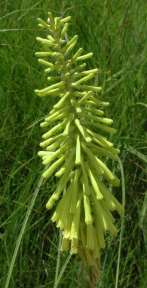Kniphofia gracilis
Kniphofia gracilis Baker
Family: Asphodelaceae
Common names: graceful/slender red-hot poker
Introduction
Kniphofias, or red-hot pokers as they are more commonly known, are popular, showy garden plants that have been valued for their dramatic appearance in South African and English gardens for over a century and a half.

Description
Description
The genus Kniphofia belongs to the lily family and its common name is derived from the flower spike, which looks like the glowing poker used in open fires. The leaves arise from an underground rhizome where nourishment is stored. When either the roots or the rhizome is damaged, the resultant wound is usually a bright yellow colour.
K. gracilis is a perennial that stands about 1 m tall, with the flower spike developing from the green/grey rosette of leaves in midsummer. The flower colour varies from yellow to bright orange with some spikes an attractive two-tone.
Conservation Status
Status
This species, though widespread, is disappearing fast due to the destruction of its grassland habitat for agriculture, tree farming and housing.
Distribution and habitat
Distribution description
K. gracilis is found in the grasslands from Pondoland in the south to Zululand in the north and from near sea level up to the foothills of the Drakensberg Mountains. Because it is deciduous, it can withstand temperatures down to just below freezing, although it is happier growing in situations where the temperature only occasionally drops below freezing.

The genus of about 70 species is found almost exclusively on the African continent, with 51 species occurring in southern Africa. The most commonly grown species are K. linearifolia and K. uvaria.
Derivation of name and historical aspects
History
The genus Kniphofia, collectively known as red-hot pokers, was named in honour of a German professor of the 18th century, J.H. Kniphof, who published a manuscript of botanical illustrations which were obtained by first coating the specimens with printers' ink and then carefully pressing them onto the paper, a process known as nature printing. The species name, gracilis, refers to the graceful/slender habit of this species.
Ecology
Ecology
The brightly coloured flowers attract bees, a variety of other insects and possibly sunbirds, which pollinate the flowers.

Uses
Use
This slender red-hot poker is not yet common in gardens and has no recorded medicinal value.
Growing Kniphofia gracilis
Grow
Kniphofia gracilis is easily grown from seed and will flower in its second year. Sow the seeds in a seed tray filled with a commercial seedling mixture and cover with about 2 mm of the mixture. Water well and keep the tray in a shady spot until the seed germinates in ± 2 weeks. When the seedlings have 3 or 4 leaves, pot them up in bags to grow on until sturdy. They can then be planted in the garden in a sunny, well-drained position.
This plant is best used as an accent plant where the greyish green leaves and colourful, slender flower spikes create a dramatic effect amongst small shrubs and perennials. It is particularly useful when planted amongst winter/spring-flowering watsonias that become dormant in summer.
References
- Codd, L.E. 1968. The South African species of Kniphofia. Bothalia 9: 363-511.
- Germishuizen, G. & Meyer, N.L. (eds). 2003. Plants of southern Africa: an annotated checklist. Strelitzia 14. National Botanical Institute, Pretoria.
- Pooley, E. 1998. A field guild to wild flowers of KwaZulu-Natal and the Eastern Region. Natal Flora Publications Trust, Durban.
Credits
Brian Tarr
KwaZulu-Natal National Botanical Garden
November 2004
Plant Attributes:
Plant Type: Bulb
SA Distribution: Eastern Cape, KwaZulu-Natal
Soil type: Loam
Flowering season: Late Summer
PH: Acid, Neutral
Flower colour: Yellow, Orange
Aspect: Full Sun
Gardening skill: Average
Special Features:
Horticultural zones









Rate this article
Article well written and informative
Rate this plant
Is this an interesting plant?
Login to add your Comment
Back to topNot registered yet? Click here to register.